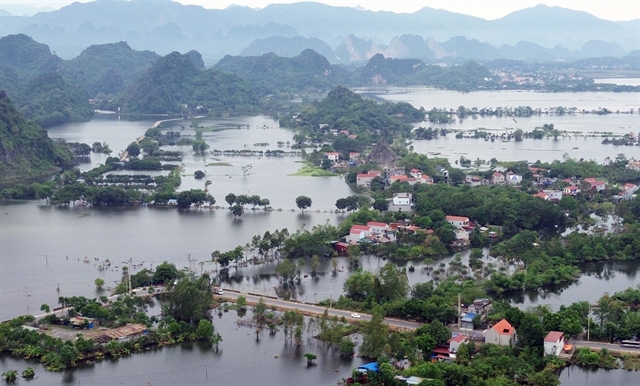 Society
Society

 |
| In front of Thiên Cung Cave, many trees show signs of drying out after being destroyed by Yagi. VNA/VNS Photo |
QUẢNG NINH Quảng Ninh is preparing to deal with forests and trees damaged in Typhoon Yagi, as the dried-out and highly flammable dead plant materials may lead to forest fires.
The news was disclosed by Nguyễn Thanh Khương, Director of Quảng Ninh Province’s Forestry Protection Department, who added that approximately six million tonnes of tree trunks, branches, roots and leaves are drying out in forests damaged by the typhoon.
Statistics show that more than 117,000 hectares of forest in Quảng Ninh have been damaged by the typhoon, with damage levels ranging from 30 to 100 per cent. These forests, mostly consisting of pine, acacia and eucalyptus trees, have been severely affected, with many trees snapped at the trunk, branches broken and all leaves stripped, rendering them incapable of recovery.
Since September 28, nine forest fires have occurred in the province, affecting more than 57 hectares. Local authorities have mobilised over 1,300 individuals, including forest rangers, police, military personnel and local forces, to actively participate in firefighting efforts.
Localities have launched campaigns to clean up and collect usable forest products from the damaged areas. Nghiêm Xuân Cường, Vice Chairman of the People’s Committee, urged local authorities and units to swiftly design firebreaks to prevent the spread of fires and mobilise forces and resources based on the 'four on-the-spot' principle. For areas with limited manpower or large-scale damage, he called for detailed plans to be developed and reported to the provincial government for reinforcement.
Quảng Ninh is implementing urgent fire prevention and control measures such as increasing patrols, providing guidance on fire prevention and maintaining a 24/7 readiness to respond to forest fire incidents.
Simultaneously, the province is preparing a plan for forest restoration. Vũ Duy Văn, Deputy Director of the Department of Agriculture and Rural Development, stated that the agricultural sector has proposed a reforestation strategy to the provincial government. The focus will shift from fast-growing trees to long-lasting timber trees and indigenous species. Localities are drafting plans to replant the damaged forests, ensuring that forest coverage returns to pre-typhoon levels by 2027.
To support the livelihoods of forest growers and "short-term economic crops for long-term gain," local authorities are guiding forest owners to select short-cycle, high-value crops while also replanting forests with indigenous and large timber trees.
On July 10, the Quảng Ninh Provincial People’s Council issued a resolution that outlines specific policies to encourage sustainable forestry development. The province provides up to VNĐ20 million (US$804) per hectare per cycle for seedling purchases and maintenance, as well as VNĐ400,000 ($16) per hectare for planning large timber tree plantations and under-canopy production. The government also allocates up to VNĐ20 million per hectare for military units engaged in large timber reforestation.
The province is also offering trust-based loans through the Social Policy Bank for members of cooperatives, households and individuals. Loan amounts are based on approved reforestation plans but will not exceed VNĐ30 million ($1,200) per hectare. Loan interest rates match those for poor households, as set by the Prime Minister, and the maximum loan term is 25 years, with no principal repayment required for the first five years. VNS